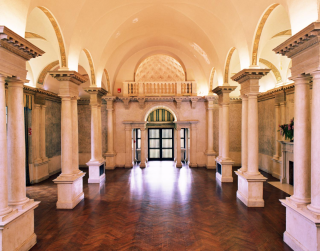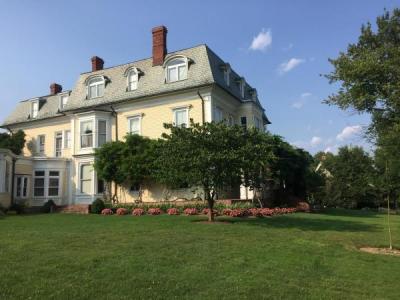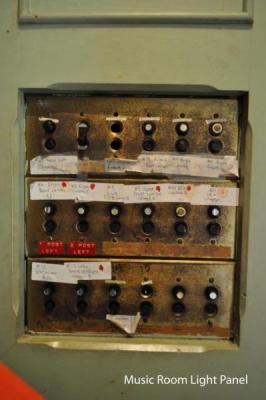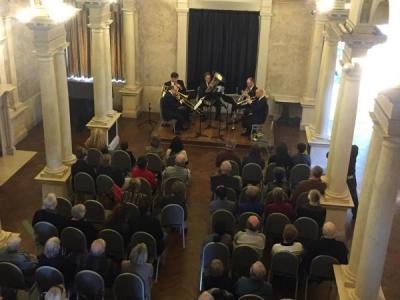Holyoke’s Wistariahurst Museum - CPA Restoring a Cultural Centerpiece for the Community

Written by Zoe Breslauer-Friedman
Holyoke’s Wistariahurst Museum, renowned for its abundance of wisteria vines planted in the 1880s, is the former family home of 19th century industrialist William Skinner, his wife Sarah, and their children. Originally constructed in the hilltowns of Williamsburg, Wistariahurst was moved to Holyoke in 1874 so that Skinner could open his silk mills and continue to facilitate business not just within the city, but also in Boston, New York, Chicago, and Philadelphia. In 1959, the youngest of Skinner’s children, Katharine, donated Wistariahurst to the city of Holyoke so that the estate could serve as a local hub of culture, education, and community. Six decades later, the museum is now in need of upgrades and repairs to the manor’s outdated electrical wiring, with an estimated cost of $353,350. Thanks to a recent award from the Holyoke CPA program, one third of the project’s expenses will be directly covered, and will allow the museum to leverage additional funding to complete the repairs.
 Wistariahurst Museum has become one of Holyoke’s historic centerpieces; Katharine Skinner Kilborne donated the property with the intention that it would serve as an emblem for the city and provide both cultural and educational opportunities for future generations. Two of the most admired elements of Wistariahurst are the Belle Skinner Music Room (named after another of Skinner’s daughters) and the garden that displays the estate’s magnificent wisteria vines.
Wistariahurst Museum has become one of Holyoke’s historic centerpieces; Katharine Skinner Kilborne donated the property with the intention that it would serve as an emblem for the city and provide both cultural and educational opportunities for future generations. Two of the most admired elements of Wistariahurst are the Belle Skinner Music Room (named after another of Skinner’s daughters) and the garden that displays the estate’s magnificent wisteria vines.
The Belle Skinner Music Room was added to the building in 1912, and housed Belle’s collection of musical instruments until they were re-located to Yale University. To honor Belle’s love for music and the room’s spirit, various performances, concerts, and special events are now held in the space. Meanwhile, the garden is often regarded as the most visually remarkable features of Wistariahurst. Upon the Skinner family’s original purchase of the home, the surrounding land was very bare, with minimal houses and trees. Sarah Skinner took great pride in cultivating the garden, and brought it to life by planting apple, pear, maple, and peach trees, along with the hallmark wisteria vines. Today, the gardens are a focal point of Wistariahurst and are maintained by a dedicated group of volunteers.
 In recent years, the museum realized there was a pressing need to update the decaying and hazardous electrical wiring at Wistariahurst in order to safely continue hosting programs and events at the facility. A combination of patchwork wiring implemented throughout prior renovations and the original electrical systems dating back over 60 years meant that essential repairs and upgrades were needed. Just a few years ago, the fuse in the Music Room blew due to the excessive toll from modern audio equipment, and multiple spot repairs over the years have unfortunately failed to address the underlying electrical problems. The $104,500 CPA award will go towards replacing two 1930’s panelboards and two 1950’s panelboards in the main part of the historic mansion, and one 1930’s panelboard in the Music Room. Although the CPA funding will not cover the entire cost, the award has enabled the museum to leverage additional funding from the Mass Cultural Council Facilities Fund.
In recent years, the museum realized there was a pressing need to update the decaying and hazardous electrical wiring at Wistariahurst in order to safely continue hosting programs and events at the facility. A combination of patchwork wiring implemented throughout prior renovations and the original electrical systems dating back over 60 years meant that essential repairs and upgrades were needed. Just a few years ago, the fuse in the Music Room blew due to the excessive toll from modern audio equipment, and multiple spot repairs over the years have unfortunately failed to address the underlying electrical problems. The $104,500 CPA award will go towards replacing two 1930’s panelboards and two 1950’s panelboards in the main part of the historic mansion, and one 1930’s panelboard in the Music Room. Although the CPA funding will not cover the entire cost, the award has enabled the museum to leverage additional funding from the Mass Cultural Council Facilities Fund.
 The city of Holyoke received 13 project proposals in FY20, totaling over $1.8 million in CPA asks, and the Wistariahurst Museum was able to receive its requested funds in full during this round. Due to the estate’s longstanding historic value and many contributions to the community’s character and local culture, it was imperative for the Holyoke Community Preservation Committee to fund the Wistariahurst’s restoration efforts. Quoted in a recent MassLive article, Museum Director Kate Preissler expressed how important the CPA funding was for preserving this essential piece of Holyoke’s history:
The city of Holyoke received 13 project proposals in FY20, totaling over $1.8 million in CPA asks, and the Wistariahurst Museum was able to receive its requested funds in full during this round. Due to the estate’s longstanding historic value and many contributions to the community’s character and local culture, it was imperative for the Holyoke Community Preservation Committee to fund the Wistariahurst’s restoration efforts. Quoted in a recent MassLive article, Museum Director Kate Preissler expressed how important the CPA funding was for preserving this essential piece of Holyoke’s history:
“I am grateful to the Committee and City Council because, without CPA funds, it may have taken us years to privately raise what is needed for a project of this scale and complexity. With the CPA and MCC combined, we will be able to cover the costs of the most pressing hazards in our electrical system and ensure that Wistariahurst remains a safe and valuable public cultural site for the foreseeable future.”

